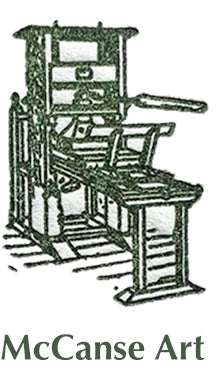Frederick Hagan
Frederick Hagan (1918 – 2003) RCA, OSA, CPE was a painter, printmaker, and influential instructor and department head at the Ontario College of Art (OCA). Hagan grew up in Cabbagetown, where he had a difficult childhood; when he was 13 years old, his father died and Hagan had to leave school to work at a paper factory to support his mother and seven siblings. Hagan was devoted to art from an early age and made a makeshift studio for himself in his family’s garage, in which he worked on paintings of his neighborhood. Hagan enrolled in night school at the Central Technical School and the Ontario College of Art (now OCAD), where he studied under John Martin Alfsen, Franklin Carmichael, and Fred Haines. Hagan’s early pieces often focused on Toronto streetscapes and working-class neighbourhoods.

Defender [Officer] of Morals. 1948. Lithograph. Edition #6/15
Credit: McCanse Art
In 1939, when Hagan was just 21 years old, four of his drawings were chosen to represent Canada at the New York World’s Fair. A few years later Hagan traveled to New York, where he had the opportunity to study at the Arts Students League with Martin Lewis. During this time he also studied printmaking at George C. Miller’s Lithography Workshop.
In 1946, Hagan returned to Canada and settled in Newmarket, Ontario, where he was employed as the Resident Artist and Master at Pickering College for a number of years. Soon Hagan relocated back to Toronto and began teaching in the evenings at the Northern Vocational School, later taking up a full-time post at OCAD in 1955. Hagan would spend the year teaching in Toronto and in the summers he would return to his home in Newmarket, where he painted his family, friends, and country life. Hagan became the head of the printmaking department at OCAD, a post he held up until his retirement in 1983. His students included Walter Bachinski, David Blackwood, and J.C. Heywood.

The Brit. Circa 1950. Lithograph. Edition #26/37.
Credit: McCanse Art
Hagan's work often focused on themes of social realism, likely inspired by his childhood in Cabbagetown. Writing in the catalogue Frederick Hagan: Ontario Northworks 1938-1991 (Laurentian University, 1992), Pamela Krueger notes Hagan’s respect and appreciation for American artists such as Thomas Hart Benton, Charles Burchfield, and artists of the Ash Can School; while the Ash Can (or Ashcan) School had no manifestos or formal organization, their work was characterized by a commitment to use art to tell “truths” about the city and modern life. Robert Henri, seen by some as a founder of the Ashcan movement, said the goal was for “art to be akin to journalism.” Henri believed working and middle-class urban settings provided better material for artists than drawing rooms and salons; a similar philosophy seems to extend to Hagan’s work and his choice of subject matter.
In 1967, Hagan was awarded the Canadian Centennial Medal, and in 1998, he was the recipient of the Royal Canadian Academy of Arts Medal. Hagan died in Newmarket in 2003. Hagan’s work is now within the collections of the Art Gallery of Ontario, the National Gallery of Canada, the Art Gallery of Hamilton, the Glenbow Museum, among others.

Circus Scene, Clowns. 1949. Lithograph. Edition #27/35
Credit: McCanse Art
Education
- Ontario College of Art, Toronto
- Art Students’ League, New York
Selected Awards
- George A. Reid Silver Award at the annual exhibition of the Canadian Society of Painter-Etchers and Engravers, 1947
Selected Exhibitions
- Royal Canadian Academy of Artists
- Ontario Society of Artists
- The Canadian Group of Painters
- The Canadian Society of Graphic Art
- The Canadian Society of Painters in Water Colour
- The Canadian Society of Painter-Etchers and Engravers
Selected Public Collections
- Art Gallery of Hamilton, Ontario
- Art Gallery of Ontario, Toronto
- Glenbow Museum, Calgary, Alberta
- National Gallery of Canada, Ottawa
